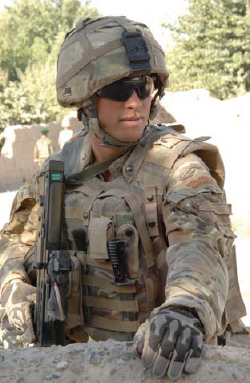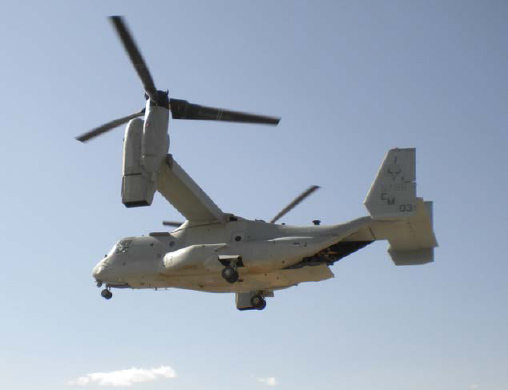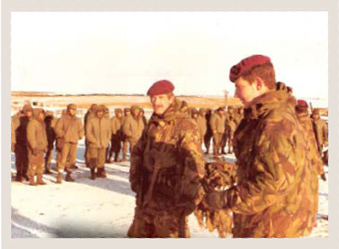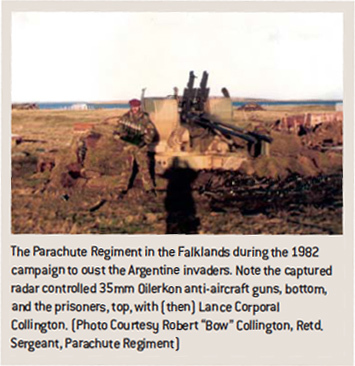To keep it simple, both types of armour are primarily waistcoats of soft armour which will stop 9mm rounds and shrapnel. They both have pockets in the front and back chest area to insert stiff armour of various types. This armour will stop rifle bullets. Using this armour pack you have to make the decision as to when to put your plates in and carry the extra weight. My advice is to wear a shrapnel-proof helmet and shrapnel-proof soft armour at all times you are at risk from enemy action. Use your discretion as to when is the time to insert the armour plate. You might want to think about this option if you are driving around rather than walking, directly attacking the enemy or entering a building to rescue hostages etc.

Body armour in action in Afghanistan. (Barry Lloyd © UK Crown Copyright, 2010, MOD)
Armour for covert operations
If you happen to work as a Spook or in plain clothes as an Special Forces operative for whatever reason then the rules change because the threat changes. I am talking now about Intelligence work in exotic countries such as Russia, the Balkans, parts of the Middle East or West Africa.
The threat: The chances are you will be wearing light-weight clothing and need to keep both armour and weapons out of sight. Unless you come up against me you are unlikely to be attacked with a hand grenade. By far the most likely threat to an agent comes from a pistol. Now, as you may know, the mechanics of a pistol oblige it to fire a relatively heavy bullet quite slowly compared to a rifle. The bullet tends to be soft so as to do the most damage to a body but it has far less kinetic energy and penetration than a rifle round. The most common calibres you will come up against in the modern world range between the 9mm automatic and the .45in automatic.
The solution: You will most likely have heard of the expression ‘bullet proof vest’. This term is usually used to describe a light-weight piece of body armour worn hidden under clothing. It covers a similar area to a T-shirt but is rather thicker. And warmer. There are various types and materials but in principle the bullet proof vest is what is called ‘Soft Armour’. This term denotes armour which ‘gives’ under the blow of the projectile and will allow severe bruising to the wearer while preventing penetration and puncture damage to the protected areas. Do be aware that after sustaining an impact wearing soft armour you may not be able to stand immediately. The main thing is, you will be able to stand later. Often there is a facility to insert extra armour plates into the front and back of these vests.
Even without plates this soft body armour will stop all normal pistol bullets. The problem comes when someone has loaded up with some of the latest armour piercing pistol rounds. Then your armour will not work except to hold your guts in. A friend of mine from the southern states of the USA and who went by the name of ‘Rebel’ spent some time as a mercenary soldier and other times as a bass player. He wore soft body armour habitually – with and without plates. You might wonder how good a guitar player he was. Only joking Reb...
SURVIVING AIR TRANSPORT
As a soldier your generals are likely to move you all over the chessboard using air transport. There isn’t a great deal you can do to protect yourself while you are flying – firing from an open chopper is only effective at low altitude – but that isn’t what I’m going to talk about here. What I want to look at here is how you protect yourself and your aircraft when it is most vulnerable – as it lands and takes off.

An Osprey leaving the scene with the back door down and a gunner on watch just visible. (Photo courtesy Tom Blakey)
We all know that aircraft are prone to damage from ground fire. Typically, fighter and ground-attack aircraft fly too fast and are too heavily armoured for anything but a specialist anti-aircraft missile to pose any threat. But that isn’t what you are going to be flying in is it?
You are going to be moved about in large, ungainly, vulnerable fixed-wing aircraft like the good old Hercules or choppers of one kind or another. You may even get a go in the Osprey – issued to the US Marines – which can change between being a helicopter and a fixed-wing aircraft.
Apart from being fairly uncomfortable for the passengers and crew, the shooting down of an aircraft is a major propaganda victory for the terrorist. There may only be a couple of people killed in a fixed-wing crash or wounded in a chopper incident but the whole idea of the terrorist being able to bring down an aircraft has a certain newsworthy ‘air’ to it which gets the video clips shown on the news all over the world.
Perhaps it is the high technology they appear to be overcoming or perhaps it’s the immense cost of aircraft they are destroying. Perhaps it is playing on the fear most people have deep down of the civilian aircraft they are flying in crashing. Whatever the reason, the terrorist will bring down an aircraft if he possibly can. You want to stop this happening if you can; and if he succeeds you don’t want to be in it.
Fixed-wing aircraft
A fixed-wing aircraft is most at risk while it is close to the ground and moving comparatively slowly. As they almost always take off from and land at airfields this is where the terrorist threat mostly lies. A fixed-wing aircraft is generally vulnerable to small-arms fire. Specifically the crew, the engines and the fuel tanks. As an accurate shot is difficult, even at close range, the terrorist will use machine guns, RPG rocket launchers or short range, shoulder-launched, anti-aircraft missiles in the hope of doing sufficient damage to bring down the aircraft. Obviously, when a fixed-wing aircraft comes down it completes the job of its own destruction.
Aircraft fuel tanks are not as vulnerable to small-arms fire as you might think. All tanks are fitted with a self-sealing system – which I won’t go into for security reasons – but which will prevent fuel loss or fire risk from small-arms fire. The point here is that the range at which a light machine gun can hope to hit a fixed-wing aircraft with sufficient rounds to do damage is rather short, say 1,000 yards maximum. An RPG has to get this close to have any hope of a hit at all. Man-portable anti-aircraft missiles don’t have much of a range either so the terrorist has to get up relatively close. Not only does the terrorist need to get close to histarget but, similar to getting directly in front of a column of vehicles, it is much easier to score a hit on an aircraft if you are shooting from dead ahead or dead astern.


To secure against this threat, the flight path to and from a fixed-wing airfield must be guarded carefully by a cordon of infantry. This often changes according to the wind direction as aircraft generally take off and land into the wind when they can. This means you should be able to work out where the terrorist is going to be positioned, spot him and stop him. If an aircraft is coming in low to drop your supplies you owe the pilot the trouble of putting out a perimeter guard or whatever you can do to protect him while he is at low altitude.
Aircraft depend on your protection when they are taking off and landing so don’t let them down. Next time it might be you going home on R&R or tapping your fingers waiting for the air-strike to bail you out of a tricky situation.
Choppers
Helicopters are much less vulnerable to small-arms fire than fixed wing aircraft, strange as this may seem. And I am talking about ordinary transport helicopters like the Blackhawk here as opposed to the flying tank called the Apache. A chopper is a relatively small target and can ‘jig around’ a lot more than a transport aircraft if the pilot thinks there is a risk. Besides this, choppers do carry armour, often a great deal of armour, and they take a lot of knocking down.